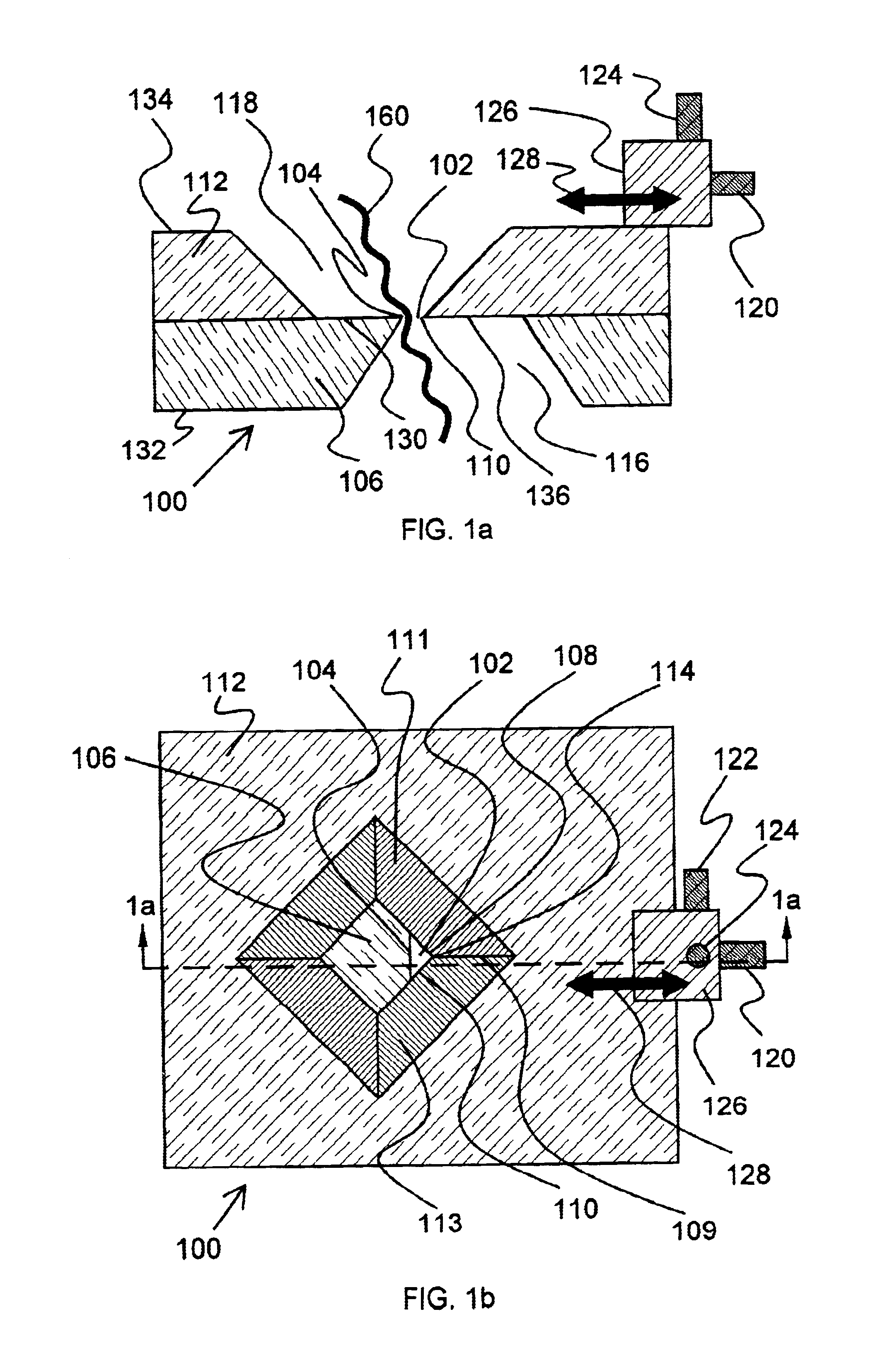Adjustable nanopore, nanotome, and nanotweezer
a nanopore and nanotome technology, applied in the direction of optical light guides, fluid speed measurement, osmosis/dialysis, etc., can solve the problems of inability to precisely predict or control the passage of an individual molecule through the pore, and the progress of nanomanipulation is slow
- Summary
- Abstract
- Description
- Claims
- Application Information
AI Technical Summary
Benefits of technology
Problems solved by technology
Method used
Image
Examples
embodiment 600
As one example, FIGS. 6a-6b illustrate an alternative embodiment 600 of the invention. Through-hole 602 exists in membrane 604. The through-hole 602 may be formed, for example, by sculpting with an argon ion beam in a membrane 604 of silicon nitride as described in J. Li et al, "Ion-beam sculpting at nanometer length scales", Nature, Vol. 412, pp. 166-169 (Jul. 12, 2001). A similar hole 606, formed, for example, by the same techniques, exists in membrane 608, which membrane can also be made of silicon nitride. The two membranes, which can for example be supported on frames (not shown) of single-crystal silicon, are placed in contact or near contact, and hole 602 is placed to intersect an edge of hole 606 to form an arched opening 610 through which a sphere 612 of diameter 614 may pass. The crown of the arch is a point 616, the springer points of the arch are at points 618 and 620, and the base of the arch is formed by the edge portion 622 of through-hole 606.
embodiment 700
Another alternative embodiment 700 of the invention is illustrated in FIGS. 7a-7b. Hole 702 in membrane 704 is formed by means similar to those used to form hole 602. Edge 706 of body 708 is part of edge 710 which bounds a planar surface of body 708. Edge 706. intersects hole 702 to form an arched opening 712 through which a sphere 714 of diameter 716 may pass. The crown of the arch is point 718, the springer points of the arch are points 720 and 722, and the base of the arch is formed by edge 706. Body 708 is formed by means of, for example, chemical vapor deposition, photolithography, and etching on a surface of substrate 724 which is later etched to form cantilever 726. Cantilever 726 may contain sensing means (not shown), such as piezoresistive sensors to monitor the contact force between membrane 704 and body 708. Such sensing means are well known to those skilled in the art of atomic force microscopy. Cantilever 726 may contain actuation means (not shown), such as piezoelectri...
embodiment 100
Variations on the structures described above may occur to those skilled in the art without departing from the scope and spirit of the present invention. For example, other cantilever structures such as those employed in STM and AFM apparatus may be incorporated into the structure of the present invention, and other flexible structures comprising springs, beams, and flexures may be incorporated into the structure of the present invention. Sensing means such as piezoelectric sensors, optical sensors, and other types of sensors may be incorporated into the present invention to aid in detecting the relative positions of the structural components of the present invention, and to aid in detecting the force with which such structural components bear upon one another. Layers such as elastomeric layers and polymeric brushes may be incorporated, for example between surfaces 130 and 136 of embodiment 100, for purposes such as elastically filling in local surface roughness.
INDUSTRIAL APPLICABIL...
PUM
| Property | Measurement | Unit |
|---|---|---|
| distance | aaaaa | aaaaa |
| distance | aaaaa | aaaaa |
| distance | aaaaa | aaaaa |
Abstract
Description
Claims
Application Information
 Login to View More
Login to View More - R&D
- Intellectual Property
- Life Sciences
- Materials
- Tech Scout
- Unparalleled Data Quality
- Higher Quality Content
- 60% Fewer Hallucinations
Browse by: Latest US Patents, China's latest patents, Technical Efficacy Thesaurus, Application Domain, Technology Topic, Popular Technical Reports.
© 2025 PatSnap. All rights reserved.Legal|Privacy policy|Modern Slavery Act Transparency Statement|Sitemap|About US| Contact US: help@patsnap.com



